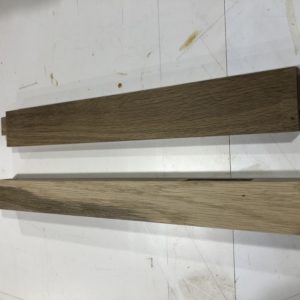Am building a Mission style coffee table from white oak and decided to fume it with ammonia following the approach in Chris Gochnour’s FWW 282 article. I ended up with somewhat uneven results and am not sure why. All the wood went through the planer then was sanded with 120 and 180 grit. I then dampened the wood to raise the grain and sanded again with 220 grit. I built a tight chamber similar to the article and dry assembled the table before putting it in the chamber with the ammonia. I could not get anything stronger than household ammonia but, based on other articles, expected to just have to wait longer. In the attached photo (after 96 hours) you can see an apron, which has turned out fine, beside a leg which seems to have reacted unevenly with the ammonia. Looking at the top of the leg I cannot see anything in the grain that would indicate heartwood/sapwood or any other variation. Am not sure what happened, and more importantly, what to do next?
Discussion Forum
Get It All!
UNLIMITED Membership is like taking a master class in woodworking for less than $10 a month.
Start Your Free TrialDiscussion Forum
Digital Plans Library
Member exclusive! – Plans for everyone – from beginners to experts – right at your fingertips.
Highlights
-
Shape Your Skills
when you sign up for our emails
This site is protected by reCAPTCHA and the Google Privacy Policy and Terms of Service apply. -
 Shop Talk Live Podcast
Shop Talk Live Podcast -
 Our favorite articles and videos
Our favorite articles and videos -
E-Learning Courses from Fine Woodworking
-
-
 Fine Woodworking New England Event
Fine Woodworking New England Event













Replies
The reason that ammonia darkens oak is the presence of tannins in the wood. Maple doesn't react to fuming because of the low levels of tannins.
Oak sapwood is low in tannins. Your piece on the left is mostly sapwood, that's why it didn't darken.
Cherry and walnut are woods that have a pronounce difference in heart and sapwood. The oaks don't. It's much harder to tell if a board is sapwood or heartwood. But boy, you can sure tell the difference after fuming, can't you.
Yup, sapwood. Bummer. Break out the stain or remake the leg.
Thanks to both of you for the replies. Confirmed my worst fears. Looks like I am now staining. Do you think the fuming will affect the absorption of the stain?
You can spot stain as needed. Stickley and Limbert did it over a hundred years ago.
The problem you encountered is one of the biggest limitations with fuming. Toxicity / respiratory distress being another common complaint.
You can buy powdered tannin which can be mixed with water and applied to the sapwood. It will then react to the chemical.
https://www.shellac.net/product650.html
One thing I found out about fuming white oak is that you should use a 28% ammonia. The other thing is that white oak from different trees will take the fuming at different rates. Usually trees from the same area of the forest will fumes at the same rate, same color. It would be heaven if you could make a project from the same tree. You will have better luck with aniline dyes and gel stains to get the same coloring. The fuming with 28% ammonia needs special respirator cartridges, eye goggles that will not let any fumes in and of course good gloves.
This forum post is now archived. Commenting has been disabled